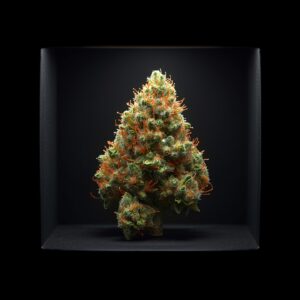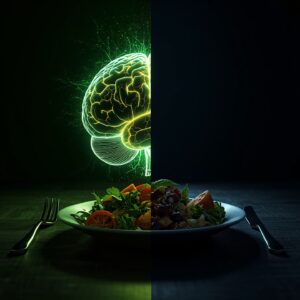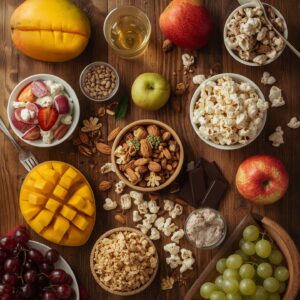The legendary talk of Cannabis and Munchies will forever crowd our thoughts after THC consumption. The reality of the story might surprise you with the facts, looking deeper in the science. Learn to educate and prepare yourself for these experiences by having healthy and wholesome food on hand.
What Are “The Munchies”

The munchies is a slang term used most often by frequent cannabis users to describe the feeling when you have an aching hunger after consuming cannabis (usually with a high THC content). Cannabinoids (especially THC) interact with the body’s endocannabinoid system, which helps regulate appetite, mood, and metabolism. THC essentially “hijacks” the brain’s hunger signals, tricking you into thinking you’re starving, even if you just ate.
Does it Happen to Everyone

Not really (no in short). We all have a different biology, when we dig a little deeper. Factors like tolerance, dosage, strain, disorders and hundreds if not thousands of other micro contributing factors effect this experience.
Tolerance

The more often you use cannabis, the less likelihood of munchies re-appearing. Regular exposure to THC desensitizes the brain’s CB1 receptors which are the same ones responsible for stimulating appetite. I have experienced some cases where over consumption even suppresses appetite largely, leading to malnutrition. A short tolerance break can reset those receptors and bring the effect back in full force (depending on tolerance).
Dosage
Small doses of THC can heighten sensory awareness, things like colours look richer, sounds feel warmer, and yes, food tastes amazing. Yet ramping up the dosage too high can backfire, leading to nausea, anxiety, or a disconnected focus that overrides hunger. For those using cannabis therapeutically to improve appetite, finding the right dosage is key, enough to engage the senses, but not so much that it overwhelms them.
Strain Type

Different strains, different effects. Indica-dominant varieties are more likely to trigger the munchies thanks to their heavier body effects and high THC content. Sativas may energize the mind and distract from eating, while hybrids fall somewhere in between.
The terpene profile matters considerably as well. Myrcene and limonene tend to boost appetite, while pinene and THCV can do the opposite. So, if you’re wondering why some strains turn you into a midnight chef and others kill your cravings, it’s the micro chemistry at work.
Disorders and Individual Chemistry
Cannabis interacts differently depending on your body’s baseline chemistry and any existing conditions. For people struggling with appetite loss due to stress, depression, or medical treatments, THC can help stimulate hunger and make food more enjoyable. On the flip side, those with metabolic disorders or anxiety might experience appetite suppression instead. Hormones, sleep quality, and even gut health all play subtle roles in how the body interprets cannabinoids, this makes the munchies far from a one-size-fits-all response.
What’s the Science Behind It, and Can It Have the Opposite Effect

THC binds to CB1 receptors in the brain’s hypothalamus, which controls hunger and satiety (your body natural “I’m full signal”). When activated, these receptors boost the release of ghrelin (“the hunger hormone”) and enhance dopamine release when eating.
But here’s the twist: certain cannabinoids like CBD or THCV can actually suppress appetite. That’s why medical patients struggling with appetite loss (like during chemo or chronic illness) often use THC-heavy strains, while others prefer THCV-rich options for appetite control or weight management.
Best Foods to Eat When You Have the Munchies

Be prepared rather than un-aware. When the munchies strike you aren’t going to be in the mood to cook a big meal nor will your ability to follow instruction carefully be at your best. This leads you to takeaways and fast food or unhealthy snacks (chocolate, sweets, chips, pastries).
Rather be prepared and cook yourself a wholesome meal before consumption, this way you can be healthy and high at the same time.
- Fruit: Fruits with texture and high-water content will be great for hydration and stimulation. Fruits like apples, mangoes, grapes, guava, litchis or even try something visually stimulation and fascinating like dragon fruit and coconut.
- Crunchy: Consume something crunchy that will keep your hands and mouth busy with getting some essential protein & fats in like peanuts and raisins, mixed nuts, popcorn or even bake up a batch of healthy crunchies. Dried fruit can be great as well.
- Protein Power: This food category is limitless, with such things like smoothies with protein powder in (mixing fruits, nuts and cultures with natural Greek yoghurt) or full blown meals that are easy to cook. Meals like spaghetti Bolognese, tuna salad, burritos, quesadillas or you can even buy a whole rotisserie cooked chicken and eat the meat straight off the bone with dipping sauce, while watching an epic movie.
- Smart snacks: Well, there are alternatives to unhealthy snacky food. Snacks like dark chocolate, jelly, corn chips with guacamole and salsa, yoghurt date balls
Conclusion
All in all, Munchies are a real thing, and they happen most often to those who are un-experienced. The lesson learnt is to rather be prepared the caught off guard and end up binge eating packets of sweets, chocolates and chips. THC can be used to increase appetite and when over dosed can cause loss of appetite. This can be used as a tool to your everyday lifestyle, if the effects stop working, take a tolerance break. Simple and easy.

